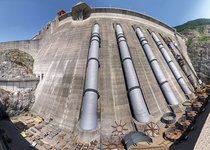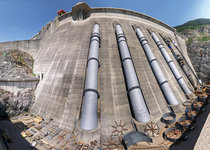Pumped hydro storage can aid renewable energy sources
The further construction of pumped hydro storage facilities could benefit both solar and hydro renewable energy sources.

 Last week PG+E, the pacific gas and electricity energy suppliers to the northern two thirds of California, looked to regulators to study the possibility of constructing a new pumped hydro storage facility in the Mokelumne River watershed in Amador County. Its construction, it is hoped, could aid the power output of other renewable energy sources such as wind and solar energy.
Last week PG+E, the pacific gas and electricity energy suppliers to the northern two thirds of California, looked to regulators to study the possibility of constructing a new pumped hydro storage facility in the Mokelumne River watershed in Amador County. Its construction, it is hoped, could aid the power output of other renewable energy sources such as wind and solar energy.
Pumped hydro storage is a form of hydro-electric power generation which stores energy in the form of water. The pumped hydro storage systems use excess electricity production, in periods of low demand, to pump water to a deposit situated at a certain height, recovering it at a later time through a turbine when it is required to cover peak load periods. Pumped storage already contributes over 90 GW worldwide – around three per cent of global generation capacity.
The system is proving increasingly attractive to engineers for several reasons; the considerable amount of energy that can be stored and a resulting power output which can be extensively regulated. This form of grid energy storage has the advantage over existing methods in that fuel-based plants do not cope with intermittent energy requirements, thus wasting energy on maintaining constant production levels.
The Mokelumne River, which supplies water to six districts in total, would be the site for a pumped hydro storage unit that could range in size from 400 MW to 1,200 MW. In comparison, one thousand mega watts is the size of one large or two medium sized power plants. California already has some 400 hydro plants which have a total dependable capacity of around 14,000 MW.
Currently, no intermittent renewable energy technologies can be used on anything other than a relatively small scale because there is no established means for storing large quantities of electrical energy at a low cost. As a result, the construction of plants run on fossil fuels continues to offer certain financial incentives.
When a subsystem involved in the generation of electricity produces energy with a high random component – such as wind farms relying to wind speed or solar panels relying on sunlight – there exists an uncertainty as to the availability of sufficient energy at any one moment. By installing an energy storage system which enables an adaptation of this irregular nature, this uncertainty can be successfully eradicated.
There are, however, certain limitations to pumped hydro storage facilities. Particularly, it could prove difficult to find topographically suitable sites with sufficient water capacity to make the installations of such systems profitable.
There has been resurgence in interest in energy storage on the grid over the last two years and a number of technologies are competing for different uses. Compressed air energy storage and modern battery technologies are just two more examples of potential low-cost means of energy storage. California alone has three other pumped hydro storage projects under construction.
The environmental benefits of pumped hydro storage are numerous, especially in combination with intermittent renewable energy sources such as solar and wind power - it is also likely to remain the cheapest means of energy storage for some time.
Author: Tom Watts | Climate Action
Images: Kam's World | Flickr





